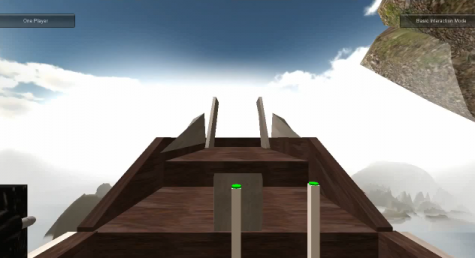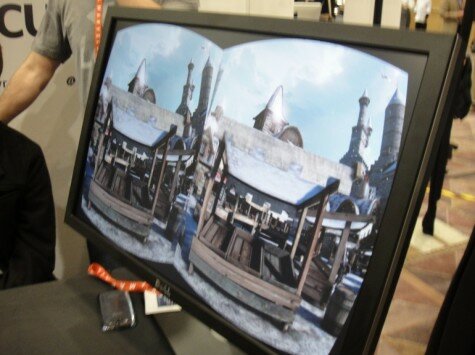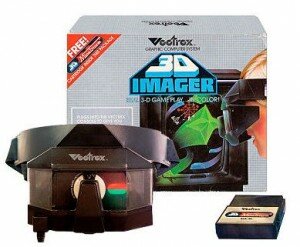Virtual reality zombie game coming to Project Holodeck

3D NEWS> 3D GAMING
Creators of the virtual reality platform Project Holodeck are developing a POV survival horror experience for the Oculus Rift
Project Holodeck Producer James Iliff told 3D Focus: “I don't know what it is about zombies, but for some reason people really want to fight them in the Holodeck so we are now working on a zombie game.”
Zombies on the Holodeck is set in an alternative version of 1940's Chicago where the population has been transformed into the undead thanks to biomechemical warfare.
The objective is to survive as long as possible, attacking incoming monsters and building defences in a contained barricade or “Hold Out” spot in the streets somewhere deep within the city. These build / attack phases run in about two minute cycles.

"Imagine how intense it is to be hammering a door shut with Hydra controllers, then hearing zombies approaching behind you from the street, and having to turn your head, pull out your handgun, aim the gun, and blow some heads off? And the gun doesn’t have infinite ammo either. In fact, you don’t know how much ammo you have unless you’re counting. To reload, you have to pick up a clip somewhere and make the physical motion to reload. The same goes for health. Say you gain health from stabbing yourself with an antidote syringe of some kind – in that case, you got to pick up a syringe and physically stab it into your arm!" writes James on the Project Holodeck website.
He continued: "The inspiration for Zombies on the Holodeck is to explore what VR might feel like if it was combined with film conventions – meaning the goal is not to convince the player that they are in a real world, but to convince the player that they are inside a film. That is the foundational idea. With that in mind, the goal of Zombies on the Holodeck is to play with horror film conventions – specifically horror film conventions from around the time Horror was invented. If we’re going to start with recognisable cliches, why not start with the original ones?"
FREE WEEKLY 3D NEWS BULLETIN –
Those who have played horror survival games such as Zombie U will know how the sense of threat and heart beat can be elevated when just using a small 2D TV, but add millimetre precise tracking of body and arms, lag free 360 degree stereoscopic visuals and binaural audio, and you could have a nervous breakdown on your hands!
"With anything that simulates real life sensations, you'll get real life side effects. Vertigo from simulated heights can sometimes occur for those who are afraid of heights. Although for many people it’s just a lot of fun." said James.
"There's no doubt in my mind that VR technology – especially something as immersive as Holodeck – has the ability to cause something like post-traumatic stress disorder, if game developers decided to make something really horrific or disturbing. The classification system for VR games will probably be one-and-the-same as the one used for conventional video games.”

The prototype Project Holodeck system requires the user to store a Lenovo laptop in a backpack
Project Holodeck is a unified virtual reality experience developed by Director Nathan Burba and Producer James Iliff with the USC Games program. The USC Games program is the top game program in the United States (according to the Princeton Review) and it has close ties with numerous developers and publishers in the industry, both in Los Angeles and beyond.
NEW PROJECT HOLODECK TRAILER
Project Holodeck Trailer V2 from James Iliff on Vimeo.
Software, hardware, design, art, writing and audio teams have been fusing consumer facing technology, custom software, rich art and integrated peripherals to create a unified virtual reality experience.
Mentors of the project include VP of Interactive Projects at Walt Disney Imagineering, Joe Garlington and Senior Game Designer, Microsoft, Richard Rouse III. Oculus Rift founder Palmer Luckey still advises on the project having being one of the original developers.

James Illif and colleague enter world of virtual reality
One of the first games being developed for Project Holodeck is Wild Skies – a co-operative VR game based on the Unity3D engine where two players guide a nuclear-powered airship through an exotic world of floating islands and dangerous storms, while fending off religious fanatics, oppressive governments, and vicious pirates with the aid of cannons, bombs, helm, afterburners, holographic indicators, a battering ram. The environment concept artwork was conceived by OTIS College of Art and Design.





Updating us on the progress of the game, James said: “We are now integrating our 3D art assets into Wild Skies and refining the mechanics. We should have a strong beta ready by May.”
For the stereoscopic visuals a Socket HMD, created by the MxR Lab at USC, is used until the Oculus Rift dev kit is available. Both HMDs share similar specs such as an 800 x 640 resolution split display and a 90 degree H/ 105 degree V field-of-view. Although humans have a near 180 degree field of view, a 90 degree F-O-V compares favourably to the 30 degrees H of the Carl Zeiss Cinemizer and 45 degrees H of the Sony HMZ-T2.

Two Playstation Move controllers and a Playstation Eye tracks your movements in 6-degrees of freedom which means you are free to walk, jump, crouch, and lean and it will be faithfully represented in the game world. One PS Move is carried in a backpack and the other is positioned on the user’s head. The Playstation Eye camera (which tracks the two Moves) has a 75 degree horizontal field of view and a 56 degree vertical field of view offering a rather large play-space to work with.

Interacting with objects is achieved with a Razer Hydra in each hand. A Razer Hydra base station is fitted to the player's head which registers the precise movement of each hand down to a millimetre using magnetic motion sensing. Grabbing or selecting an object is achieved with the press of a button on the controllers. In Wild Skies, to grab swords from your back, you would behave how you would in the real world. You literally reach over your head and behind your back and grab them… pull your arms forward and now you’re wielding two swords.

The Razer Hydra allows for precise interaction in the Holodeck
Razer are now the official sponsor of Project Holodeck and supply free kit.
EXCLUSIVE
We recently spoke to James Iliff to find out what Project Holodeck and Oculus Rift could mean for the games industry…
3D Focus: How is Project Holodeck different to simply using an Oculus Rift? Is it because it allows for multi-player experiences?
James Iliff: Project Holodeck can be a single-player or multi-player experience. Holodeck adds to the Oculus experience with the addition of motion controls and positional tracking of the head and hands. In other words, you’re not sitting down playing a game with a controller + Rift. You can stand up, move around and interact in three dimensional space. You can pull out a revolver and aim down the barrel just like you would in real life. You can pull out a sword and have swordfights like you would in real life. It’s an extra layer of immersion by adding full motion tracking to the VR experience – which is already super immersive with the peripheral stereoscopic vision the Rift provides.
3D Focus: What feedback did you receive when you showcased Project Holodeck at the GAME: NEXT exhibit in Dublin?
James Iliff: People loved it. We got a ton of requests for a Zombie game – so that is why we are making one. The biggest changes people suggested were to have real art in the game – which is something we are working on with Gnomon. Right now it’s still "programmer art" so things are quite blocky. But that's part of the game design process. You gotta make sure it’s fun before its pretty – although being pretty is that much more important in VR. Other than that, condensing the size of the helmet rig to something more manageable and comfortable is one of our top priorities.
3D Focus: If Project Holodeck uses off-the-shelf hardware – how will it be protected/commercialised?
James Iliff: The Oculus Rift is still the centrepiece of our development process, and we still plan on complementing it with our own wearable computing solutions. We're working on a number of solutions right now that's going to take our proof-of-concept to the next level, which doesn't use off-the-shelf hardware.
FREE WEEKLY 3D NEWS BULLETIN –
3D Focus: I understand you are looking at making Holodeck solutions for "arcade" environments. Can you elaborate on that?
James Iliff: I can't go too much into this yet, but I will say that Holodeck is very modular. From the beginning, we've developed our system to be used with many kinds of hardware in different combinations, or even none at all. For instance, you can choose in a settings screen to play a game with simple controllers, or controllers + VR headset, or Razer Hydra + VR headset, or Hydra + VR headset + PS Move, or any combination of these. This means developers and gamers can choose to use what they have available to them, or opt in for the full setup for the most immersive experience possible.
3D Focus: Why is Project Holodeck so closely linked to the Oculus Rift?
James Iliff: I worked with Palmer Luckey (Founder of LLC) on virtual reality projects starting back in 2011 through the MxR Lab, and Nathan Burba also worked with him at MxR focusing on motion tracking technologies.

When the project started, Palmer Luckey (creator of the Oculus Rift) was the lead hardware engineer for the project. Since then, he’s now moved to what Project Holodeck Director Nathan Burba called a ‘hardware adviser’ role. Long story short — Luckey has a lot on his hands with the Oculus Rift, though he’s helping the Project Holodeck team with head mounted displays.

A Gizmag journalist tries the Oculus Rift at CES 2013
At IEEE VR in March 2012, Nathan Burba, Palmer, and I had the idea to create a fully immersive virtual reality gaming system at a consumer-level cost. We had worked with professional level motion capture systems and military-grade VR head mounts prior to this and the cost all of that technology was in the hundreds of thousands of dollars. We realised we could accomplish 90% of the immersion of super expensive systems, for 5% of the cost. Palmer was already working on a new HMD prototype he called the 'Rift' that would build upon his previous PR4 and PR3 prototypes, and we were already developing a cheap motion capture solution for VR gaming, so we decided to launch 'Project Holodeck' to bring this vision of affordable, highly immersive VR to life.

A Gizmag screenshot of the left and right viewpoints used to generate a stereoscopic image on the Oculus Rift
Nathan and I then pitched it to the highly competitive Advanced Games program at USC. Around this same time, Palmer was contacted by John Carmack, who wanted to borrow his HMD to test it out with Doom 3. John had been working with VR hardware for some time and was planning on making his own headset – but after he learned of Palmer's Kickstarter plans and read about his new model on the MTBS forums, he reached out to give it a try. After that, John took the Rift to E3 2012 and the rest is history! Palmer started his company and the Kickstarter was a wild success. We started the Advanced Games class in August 2012, brought on 20 USC students to the project, and forged partnerships with OTIS, LCAD, and Gnomon.

3D in a spin Almost 30 years before the Oculus Rift, the Vectrex 3D Imager was launched – the first 3D game accessory.
Designed for the vector graphics based Vectrex, the US only goggles used a spinning translucent colour wheel to generate a stereoscopic effect.
Half of the wheel was black and the other half was coloured so each eye would see a render of a different perspective generated by the console, synced via a cable.
Only three games were produced for the Vectrex 3D Imager and sales were low, making it extremely rare and sought after today. Sega followed four years later with a 3D goggle peripheral in 1988.
|
Both Oculus and Project Holodeck have been working furiously ever since to bring VR to the next level. With so many developers having ordered Rift, Oculus has single-handedly transformed the games industry and is bringing virtual reality to consumers once again. And we are still sticking with our original plan to build on Palmer's head-mount for a fully embodied immersive VR experience. Viva la VRevolution!
3D Focus: Where will the content come from? For example, if Wild Skies is only playable in a Project Holodeck environment won’t indie and major game publishers shy away from investing money into Project Holodeck experiences when the potential audience will be small?
James Iliff: Wild Skies isn't only playable on Project Holodeck due to its modular design. Like I described earlier, our games are actually compatible with various combinations of hardware, from complete VR setups all the way down to simple mouse and keyboard controls. This is done both for development purposes and to appeal to a wider audience. So for our games, including Wild Skies, the audience isn't actually diminished at all. Anyone with a computer will be able to play. But for those who want a bigger and better experience, they can play in the full Holodeck. With that in mind, I can see VR pipelines being integrated into existing game development pipelines, with indie developers lending more attention to the benefits new hardware can provide.
3D Focus: Will Project Holodeck revitalise the arcade?
James Iliff: Absolutely! I think arcades can return, but in new ways that you might not expect.
3D Focus: Could Project Holodeck be integrated with NeuroSky technology?
James Iliff: EEG technologies like NeuroSky and Emotiv are super cool! It still does take some time for your thoughts to translate into actions, and that latency will eventually be worked out. Once it functions fast enough it could definitely be integrated with VR tech!
3D Focus: Why do you think it has taken so long for virtual reality to become reality? Surely the required processing power has been around for quite some time?
James Iliff: The revolution of compact displays with high resolution was burgeoned by the smart phone market over the past six years. Because of this, we now have displays that are small enough, light enough, and high resolution enough to support simple optics without using cumbersome lenses or OLED displays. It can only have happened now.
3D Focus: What technology will be required for the next level of virtual reality?
James Iliff: For headsets I think increasing the peripheral vision will always be a goal, in addition to reducing latency and providing positional tracking. A simple positional tracking solution would be a huge step forward.
3D Focus: With space being limited, how will people move through a space? (ie forwards, backwards). Will that be a hand controller? In this video, they change the scene slightly to create a sense of space. Will you be doing things like that in Wild Skies?
James Iliff: You move in any direction just by moving – your whole body is positionally tracked. However, the play zone is only as large as the range of the camera. If players want to walk or run for miles in a virtual environment, there are a number of solutions. Joysticks are one solution. Another one is omni-directional treadmills, or in-place locomotion. In Wild Skies, we allow players to pilot vehicles (airships) so they can explore anywhere while being physically contained on the deck of a ship. There's lots of interesting design constraints when working with VR and we're just beginning to scratch the surface!
3D Focus: Will audio be encoded in special ways to enhance realism in Wild Skies?
James Iliff: We're experimenting with binaural audio. Palmer likes to toy around with galvanic vestibular stimulation, and that's super interesting as well – it involves stimulation of the inner ear to shift a person's sense of balance. But we prefer to risk permanent hearing loss – over permanent balance loss, any day.
3D Focus: What other applications, aside from gaming, do you expect Project Holodeck to be used for?
James Iliff: Virtually anything, no pun intended! Okay, pun intended. But it could be used for Architectural applications, Military training simulations, and even an entire app marketplace much like the smart phone marketplaces that exist today.
FREE WEEKLY 3D NEWS BULLETIN –






















